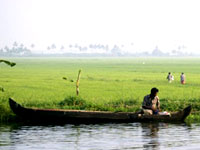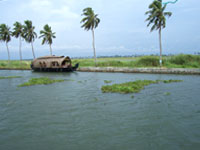 Nick-named as the Netherlands or Holland of Kerala, the Kuttanad area in the main backwaters region, is also described as the ‘rice-bowl’ of southern Kerala, on account of the extensive paddy (rice) fields surrounded by water. There are two distinctive areas here-viz. Lower and Upper Kuttanad-based on altitude or height above sea-level or depth below sea-level. It is the Lower Kuttanadu region that is called the ‘nether-lands’, because the cultivated lands are below sea level. As in Holland, dykes or bunds around the rice fields keep out water when needed, thereby enabling cultivation. Nick-named as the Netherlands or Holland of Kerala, the Kuttanad area in the main backwaters region, is also described as the ‘rice-bowl’ of southern Kerala, on account of the extensive paddy (rice) fields surrounded by water. There are two distinctive areas here-viz. Lower and Upper Kuttanad-based on altitude or height above sea-level or depth below sea-level. It is the Lower Kuttanadu region that is called the ‘nether-lands’, because the cultivated lands are below sea level. As in Holland, dykes or bunds around the rice fields keep out water when needed, thereby enabling cultivation.
The Upper Kuttanad area is a little above sea level, so that cultivation of crops is easier and less risky. During rainy season, floods are usual in the entire lowland region and so rice cultivation is possible only once a year, unlike twice at many places in Kerala, where waterlogging is not a problem. Floods often damage the bunds causing submergence of the paddy fields and loss of crops. So, cultivation is limited to only one crop per year at many places in the area.
The scenic countryside of Kuttanadu also has rich crops of coconuts, banana, fruit trees, etc. wherever geography allows. Homesteads, schools, shops, churches, temples and other buildings, are situated amidst the lush vegetation at a higher elevation than the rice fields and the zig-zagging canals and meandering river branches. An amazing feature of this region is the network of waterways above land level at several places.
Kuttanad region sprawls out into the neighboring districts of Kottayam and Pathanamthitta in addition to Alappuzha district. Fresh water from four rivers (Pampa, Achankovil, Manimala and Meenachil) flowing down from the highlands through the midlands irrigate the vast lowlands rice fields and also prevent entry of salty sea water, except during dry season.
 A boat ride on the backwaters of this region will take tourists meandering through the serpentine canals, at times just broad enough for two large boats to pass through. Surrounded by miles and miles of paddy fields at a lower level than the canals and the ubiquitous coconut palms lining the narrow embankments (bunds) on the fringes of the fields, tourists are treated to vignettes from the daily lives of village folks living along the shore. And as the boat emerges from the labyrinth of canals, the wide expanse of the lake appears in front. Sometimes, when the tree line at the far horizon lies obscured in mist or haze of rain, the lake almost resembles a sea with ripples of waves and white foam on their crests. A boat ride on the backwaters of this region will take tourists meandering through the serpentine canals, at times just broad enough for two large boats to pass through. Surrounded by miles and miles of paddy fields at a lower level than the canals and the ubiquitous coconut palms lining the narrow embankments (bunds) on the fringes of the fields, tourists are treated to vignettes from the daily lives of village folks living along the shore. And as the boat emerges from the labyrinth of canals, the wide expanse of the lake appears in front. Sometimes, when the tree line at the far horizon lies obscured in mist or haze of rain, the lake almost resembles a sea with ripples of waves and white foam on their crests.
Kuttanad (Kerala’s Netherlands)
Upper Kuttanad
Development Plans
Central and state governments are currently paying attention to the agricultural and transport problems faced by the Kuttanad region in the lowlands. A commission chaired by the eminent agricultural scientist hailing from Kuttanad area, M.S Swaminathan is currently studying the various problems faced by the area to suggest solutions. A district-level expert committee is preparing a report to be submitted to this commission and is exploring the possibility of widening and deepening the canals in the Upper Kuttanad region to facilitate smooth water transport.
Improving the condition of the canals would encourage inland navigation and backwater and farm tourism, as well as lead to agricultural development.
This experts’ committee is also looking into the feasibility of raising two crops in the paddy fields of Upper Kuttanad, by strengthening the bunds (or earth walls) around the paddy field clusters. These bunds should be strong enough to resist the pressure of water at a higher level during rainy season-especially when floods occur. The prevailing system of flushing out water from the paddy fields lying below sea level, to the bordering canals and river branches at a higher level, and releasing water into the fields from the canals as and when needed, would be improved.
Further developments
For the further development of the Kuttanad region, plans are being prepared to promote aquaculture and duck farming also, along with paddy (rice) cultivation. Fresh water fishes can be grown in the paddy fields during flood periods and when fields are left uncultivated. As cost of production of rice has been increasing in Kerala, many rice fields are not cultivated now. Such fields can be utilized for pisci-culture and also duck (water-fowl) farming. These projects are meant only for the backwater lowland region of Alappuzha district and adjacent areas of neighboring districts.
Development of the waterways by way of deepening and widening, will facilitate water transport and backwater tourism. It is expected that such developmental plans would be implemented in the near future, as the state and union governments are allocating more funds for the purpose. |
 Nick-named as the Netherlands or Holland of Kerala, the Kuttanad area in the main backwaters region, is also described as the ‘rice-bowl’ of southern Kerala, on account of the extensive paddy (rice) fields surrounded by water. There are two distinctive areas here-viz. Lower and Upper Kuttanad-based on altitude or height above sea-level or depth below sea-level. It is the Lower Kuttanadu region that is called the ‘nether-lands’, because the cultivated lands are below sea level. As in Holland, dykes or bunds around the rice fields keep out water when needed, thereby enabling cultivation.
Nick-named as the Netherlands or Holland of Kerala, the Kuttanad area in the main backwaters region, is also described as the ‘rice-bowl’ of southern Kerala, on account of the extensive paddy (rice) fields surrounded by water. There are two distinctive areas here-viz. Lower and Upper Kuttanad-based on altitude or height above sea-level or depth below sea-level. It is the Lower Kuttanadu region that is called the ‘nether-lands’, because the cultivated lands are below sea level. As in Holland, dykes or bunds around the rice fields keep out water when needed, thereby enabling cultivation. A boat ride on the backwaters of this region will take tourists meandering through the serpentine canals, at times just broad enough for two large boats to pass through. Surrounded by miles and miles of paddy fields at a lower level than the canals and the ubiquitous coconut palms lining the narrow embankments (bunds) on the fringes of the fields, tourists are treated to vignettes from the daily lives of village folks living along the shore. And as the boat emerges from the labyrinth of canals, the wide expanse of the lake appears in front. Sometimes, when the tree line at the far horizon lies obscured in mist or haze of rain, the lake almost resembles a sea with ripples of waves and white foam on their crests.
A boat ride on the backwaters of this region will take tourists meandering through the serpentine canals, at times just broad enough for two large boats to pass through. Surrounded by miles and miles of paddy fields at a lower level than the canals and the ubiquitous coconut palms lining the narrow embankments (bunds) on the fringes of the fields, tourists are treated to vignettes from the daily lives of village folks living along the shore. And as the boat emerges from the labyrinth of canals, the wide expanse of the lake appears in front. Sometimes, when the tree line at the far horizon lies obscured in mist or haze of rain, the lake almost resembles a sea with ripples of waves and white foam on their crests.